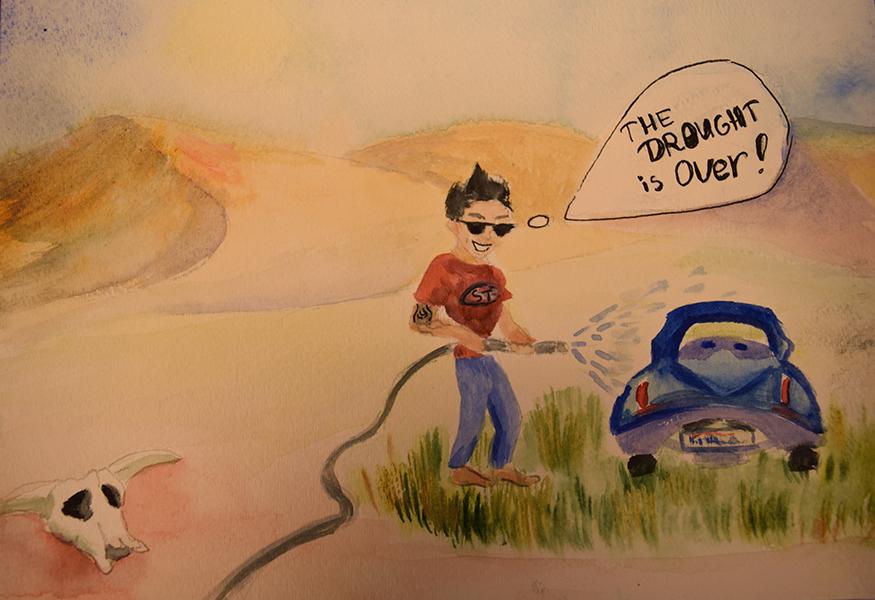Is California’s drought over?
February 28, 2016
 From farmers trying to stay afloat in the Central Valley to your neighbor trying to keep his lawn green, people all over the state are asking themselves, is the drought over?
From farmers trying to stay afloat in the Central Valley to your neighbor trying to keep his lawn green, people all over the state are asking themselves, is the drought over?
After an unusually rainy winter during which San Jose received 103 percent of normal rainfall, long-range meteorologists say that the strong El Niño weather pattern is not over and that we should expect more rain. According to long-range weather forecasts from the National Oceanic and Atmospheric Association and Columbia University, there is a 62 percent chance of rain through May.
So, is it over? Can we go back to leaving the tap on as we brush our teeth and over-watering our lawns?
Not yet. Maybe, never. The stresses being placed on California’s water resources are extreme. A lack of rainfall is only the beginning of the story. The booming California economy along with continued urbanization and population growth will force the state’s residents to rethink our priorities around water use.
The dictionary definition of a drought is, “a period of dryness, especially when prolonged.”
Before it started raining this winter, the Santa Clara Valley Water District— the drinking water wholesaler for Santa Clara County—said that local reservoirs are about half full. The county’s groundwater basins, the giant underground reservoirs of water, were 30 to 40 feet lower than average.
In response, California’s water regulators have extended the emergency drought restrictions into 2016. Locally, this means that the water district will continue to call for a water use reduction target of 30 percent and limit the watering of outdoor landscapes and lawns to two days per week.
Our prospects for more water seem to have taken a turn for the better this winter. This month, state water experts reported that the Sierra Nevada snowpack was at 115 percent of normal. A year ago, it was only 23 percent. Things are definitely looking up.
Not so fast. According to Peter Gleick, president and co-founder of the Pacific Institute, how we define a drought is important if we’re going to determine if the current one is over.
“We’re in a deeper hole than one year is going to fill,” Gleick said in a recent interview with Public Radio International’s Living on Earth program. Gleick went on to remind people living in California
that one wet year is not enough to end the five-year drought. Gleick pointed to low soil moisture and overdrafted groundwater aquifers as reasons for maintaining our water conservation habits.
From a rainfall perspective, the evidence is clearly shows we’re not out of the woods yet. But, what about our long-term prospects?
In order to understand how California’s water needs in the long run, consider the continued long-term growth prospects of the state’s population. According to the State Department of Finance, California’s population is expected to increase from over 37 million in 2010 to 52.6 million by 2060, an increase of 41 percent.
The stresses on California’s natural resources and the opportunities for economic prosperity here have made the state a victim of its own success. The ambitious expansion plans of Apple Inc. are a prime example.
Apple has recently announced massive expansion plans into Downtown San Jose that, in terms of square feet, will be as big as their new Cupertino world headquarters building. In the near future, as many as 20,000 Apple employees will work in San Jose’s North First Street high-tech corridor.
In addition, high-speed rail will allow people living in the rural areas south of Silicon Valley to get to downtown in less than an hour. This unprecedented urbanization will place greater stresses on the region’s water resources.
Because of the drought and our past over-consumptive water use habits, we have dug ourselves a deep dry hole that, according to Gleick, will take more than one year to dig ourselves out.
We may all want to know when the drought will be over. But, if you want to know so you can go back to our water wasting ways, then you’re out of luck. The future of California is going to be defined by less waste and greater efficiency in all things – including how we use water.
The time has arrived to begin thinking about water differently. To be sure, we are in a drought. Define it any way you wish. California is continuing to grow, and we cannot expect to go on using water as before. Green lawns, tropical flowers and raising cattle in the middle of the desert, must be replaced by native grasses, drought tolerant plants and food production that uses less water.
Gleick summed it up well in a recent tweet, “If the definition [of a drought] is not having enough water to do everything one wants, maybe we’re in permanent drought.”

